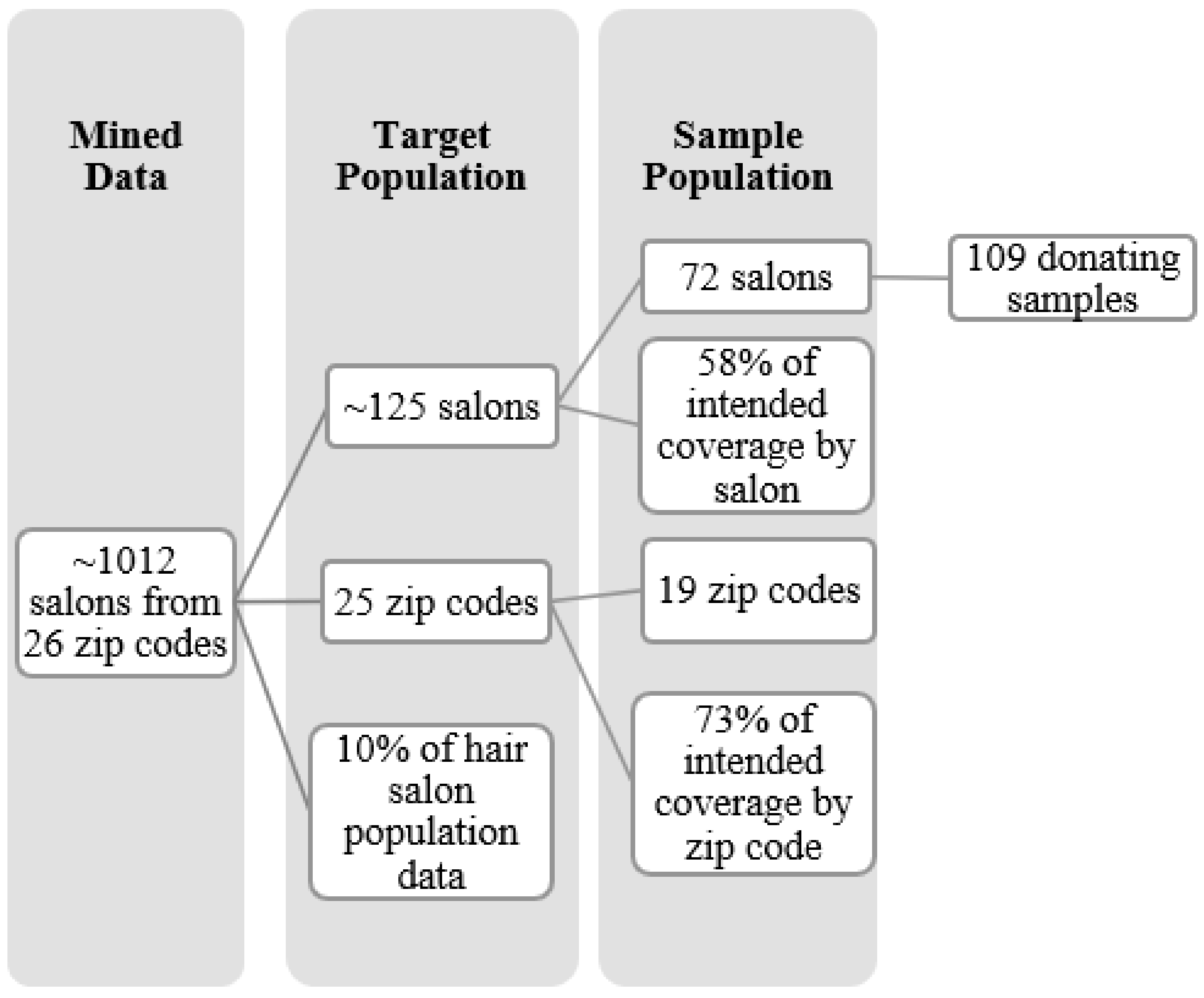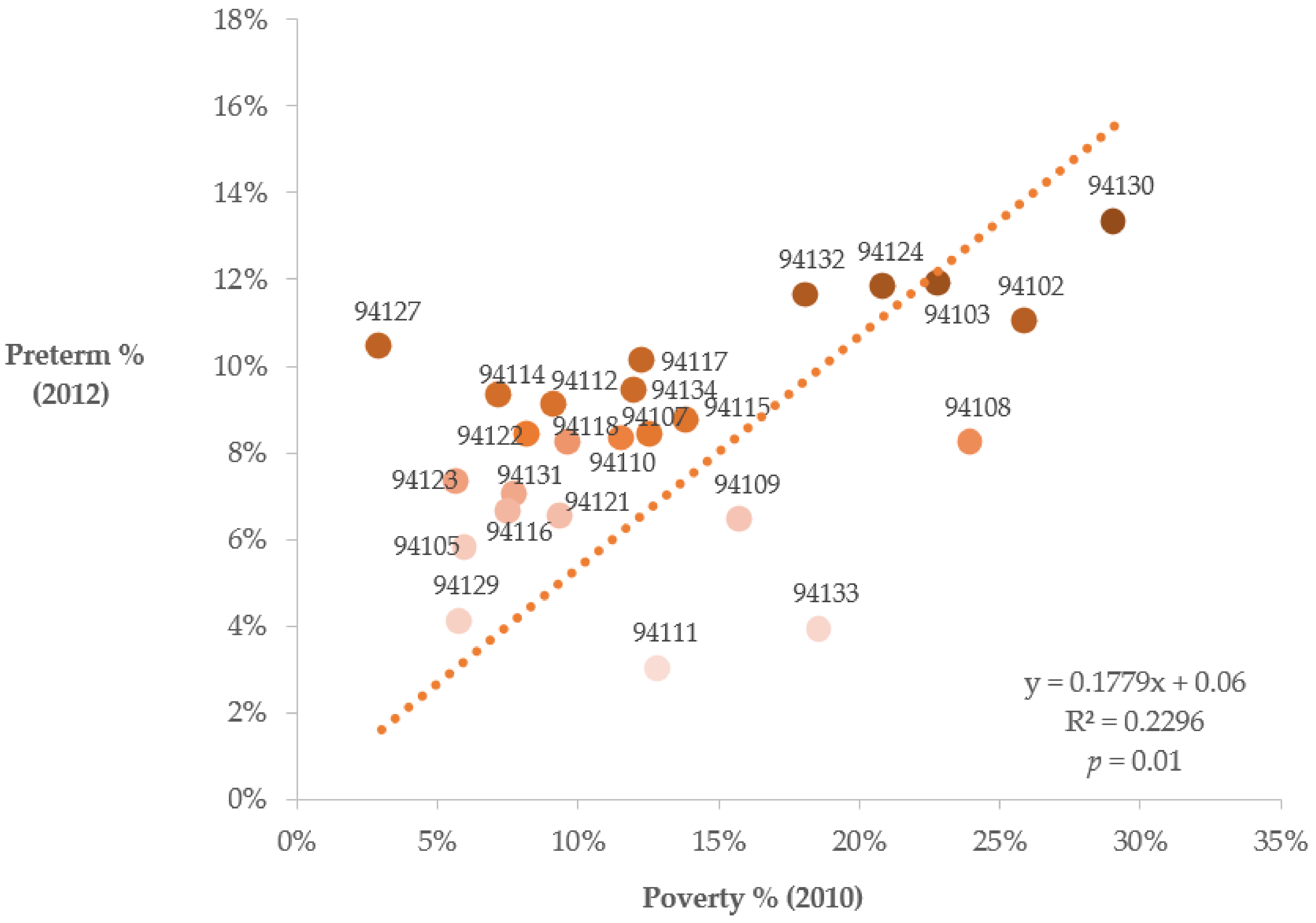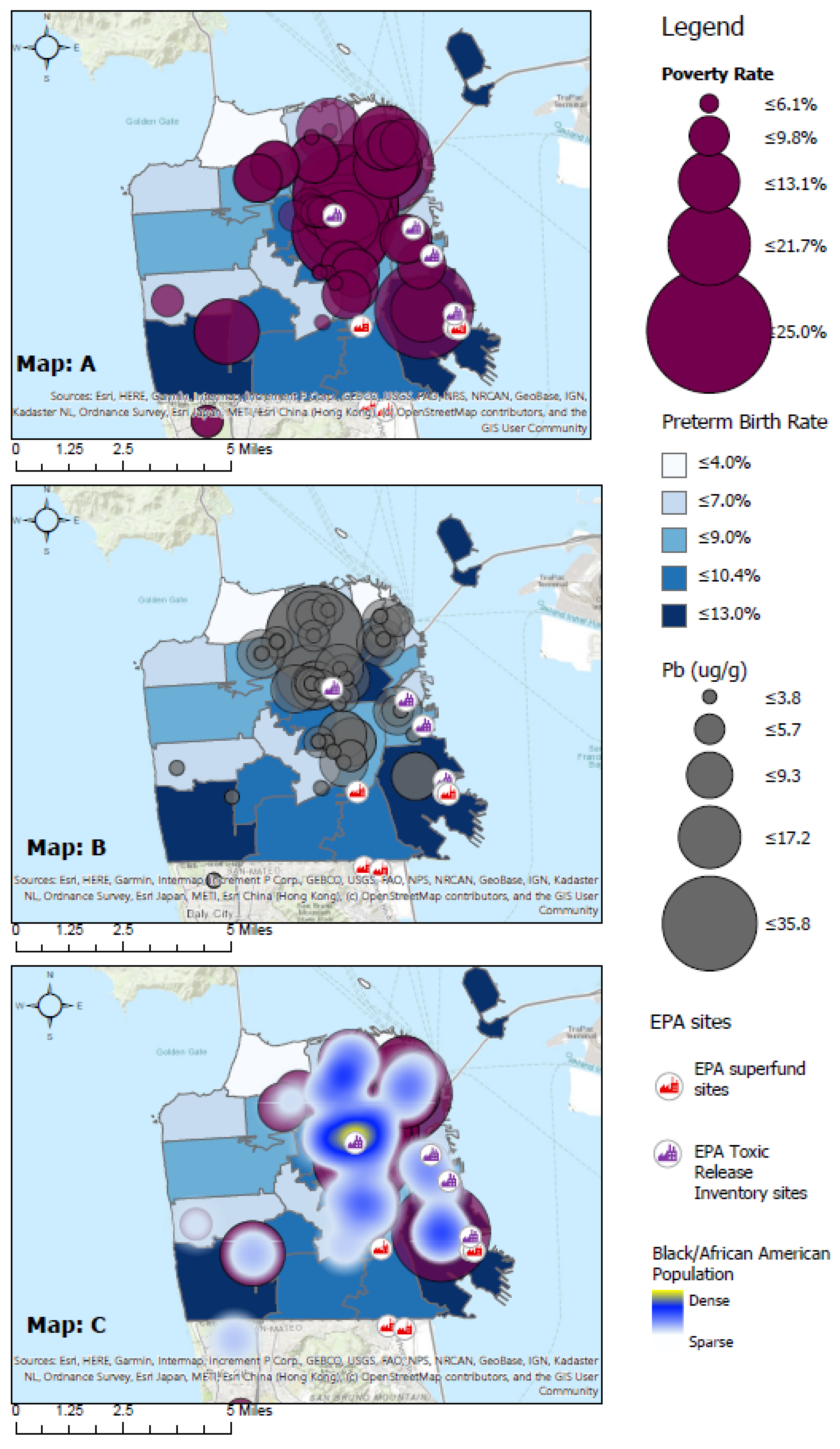Geospatial Distributions of Lead Levels Found in Human Hair and Preterm Birth in San Francisco Neighborhoods
Abstract
:1. Introduction
2. Materials and Methods
2.1. Participants and Study Design
2.2. Biospecimen Collection and Processing Procedures
2.2.1. Random Selection of Salons
2.2.2. Collection of Hair Samples
2.2.3. Processing of Hair and Pb Measurement
2.3. Data Analyses and Visualization
2.3.1. Sources of Data and Statistical Analyses
2.3.2. Data Visualization
3. Results
3.1. Pb Concentrations in Human Hair and Social Determinants Distribution in San Francisco
3.2. Poverty and PTB Distribution in SF
3.3. Relationship between Pb Concentrations and Preterm Birth Rate, Education, and Ethnicity
3.4. Geospatial Representation of the Distribution of Pb in San Francisco
4. Discussion
4.1. Primary Findings
4.2. Perspective of Previous Studies
4.3. Implications of Findings
4.4. Future Directions
Limitations and Delimitations
5. Conclusions
Supplementary Materials
Author Contributions
Funding
Institutional Review Board Statement
Informed Consent Statement
Data Availability Statement
Acknowledgments
Conflicts of Interest
References
- Romero, R.; Dey, S.K.; Fisher, S.J. Preterm labor: One syndrome, many causes. Science 2014, 345, 760–765. [Google Scholar] [CrossRef]
- Braveman, P.; Gottlieb, L. The social determinants of health: It’s time to consider the causes of the causes. Public Health Rep. 2014, 129, 19–31. [Google Scholar] [CrossRef]
- Kim, H.-C.; Jang, T.-W.; Chae, H.-J.; Choi, W.-J.; Ha, M.-N.; Ye, B.-J.; Kim, B.-G.; Jeon, M.-J.; Kim, S.-Y.; Hong, Y.-S. Evaluation and management of lead exposure. Ann. Occup. Environ. Med. 2015, 27, 30. [Google Scholar] [CrossRef] [PubMed]
- United States Department of Labor. 1910.1025 App A—Substance Data Sheet for Occupational Exposure to Lead, Occupational Safety and Health Administration. OSHA. 1991. Available online: https://www.osha.gov/laws-regs/regulations/standardnumber/1910/1910.1025AppA (accessed on 28 June 2020).
- Curtis, C.; Reiter, R. Data Brief: Birth Data for San Francisco Residents 2012; San Francisco Department of Public Health—Maternal, Child & Adolescent Health: San Francisco, CA, USA, 2012; p. 6. Available online: https://www.sfdph.org/dph/files/MCHdocs/Epi/Birth-Data-Summary-SF.pdf (accessed on 27 July 2019).
- Maness, S.B.; Buhi, E.R. Associations between social determinants of health and pregnancy among young people: A systematic review of research published during the past 25 years. Public Health Rep. 2016, 131, 86–99. [Google Scholar] [CrossRef]
- United States Department of Labor. Substance Data Sheet for Occupational Exposure to Lead—1910.1025 App A. OSHA. 1991. Available online: https://www.osha.gov/pls/oshaweb/owadisp.show_document?p_table=STANDARDS&p_id=10031 (accessed on 28 June 2020).
- United States Department of Labor. OSHA Fact Sheet: Protecting Workers from Lead Hazards. Occupational Safety and Health Administration. OSHA. Available online: https://www.osha.gov/OshDoc/data_Hurricane_Facts/LeadHazards.html (accessed on 11 May 2020).
- Hirsch, D.; Altenbern, T.; Caine, M.; Williams, H.; Gortner, D. Hunters Point Shipyard Cleanup Used Outdated and Grossly Non-Protective Cleanup Standards. 2018. Available online: https://www.committeetobridgethegap.org/wp-content/uploads/2018/10/HuntersPtReport3CleanupStandards.pdf (accessed on 10 May 2020).
- Bayview Hunters Point Mothers Environmental Health & Justice Committee; Huntersview Tenants Association; Greenaction for Health & Environmental Justice. Pollution, Health, Environmental Racism and Injustice: A Toxic Inventory of Bayview Hunters Point, San Francisco. September 2004. Available online: https://greenaction.org/wp-content/uploads/2019/06/thestateoftheenvironment090204final.pdf (accessed on 25 March 2021).
- US EPA. Hunters Point Naval Shipyard San Francisco, CA. Superfund Site. Available online: https://cumulis.epa.gov/supercpad/cursites/csitinfo.cfm?id=0902722 (accessed on 18 November 2019).
- Barbosa, F.; Tanus-Santos, J.E.; Gerlach, R.F.; Parsons, P. A Critical Review of Biomarkers Used for Monitoring Human Exposure to Lead: Advantages, Limitations, and Future Needs. Environ. Health Perspect. 2005, 113, 1669–1674. [Google Scholar] [CrossRef] [PubMed]
- PBHA-Clinical: Lead, Hair. 1995. Available online: https://www.mayomedicallaboratories.com/test-catalog/Clinical+and+Interpretive/8495 (accessed on 15 April 2018).
- Nowak, B.; Chmielnicka, J. Relationship of lead and cadmium to essential elements in hair, teeth, and nails of environmentally exposed people. Ecotoxicol. Environ. Saf. 2000, 46, 265–274. [Google Scholar] [CrossRef]
- Niculescu, T.; Dumitru, R.; Botha, V.; Alexandrescu, R.; Manolescu, N. Relationship between the lead concentration in hair and occupational exposure. Occup. Environ. Med. 1983, 40, 67–70. [Google Scholar] [CrossRef]
- Sreenivasa, R.K.; Balaji, T.; Prasada, R.T.; Babu, Y.; Naidu, G.R.K. Determination of iron, cobalt, nickel, manganese, zinc, copper, cadmium and lead in human hair by inductively coupled plasma-atomic emission spectrometry. Spectrochim. Acta Part B Spectrosc. 2002, 57, 1333–1338. [Google Scholar] [CrossRef]
- Jan, A.T.; Azam, M.; Siddiqui, K.; Ali, A.; Choi, I.; Haq, Q.M.R. Heavy metals and human health: Mechanistic insight into toxicity and counter defense system of antioxidants. Int. J. Mol. Sci. 2015, 16, 29592–29630. [Google Scholar] [CrossRef]
- Esteban-Vasallo, M.D.; Aragones, N.; Pollan, M.; Lopez-Abente, G.; Perez-Gomez, B. Mercury, cadmium, and lead levels in human placenta: A systematic review. Environ. Health Perspect. 2012, 120, 1369–1377. [Google Scholar] [CrossRef]
- Woodruff, T.J.; Zota, A.; Schwartz, J.M. Environmental chemicals in pregnant women in the United States: NHANES 2003–2004. Environ. Health Perspect. 2011, 119, 878–885. [Google Scholar] [CrossRef]
- Sanders, A.P.; Flood, K.; Chiang, S.; Herring, A.H.; Wolf, L.; Fry, R.C. Towards prenatal biomonitoring in North Carolina: Assessing arsenic, cadmium, mercury, and lead levels in pregnant women. PLoS ONE 2012, 7, e31354. [Google Scholar] [CrossRef] [PubMed]
- Chen, Z.; Myers, R.P.; Wei, T.; Bind, E.; Kassim, P.; Wang, G.; Ji, Y.; Hong, X.; Caruso, D.; Bartell, T.; et al. Placental transfer and concentrations of cadmium, mercury, lead, and selenium in mothers, newborns, and young children. J. Expo. Sci. Environ. Epidemiol. 2014, 24, 537–544. [Google Scholar] [CrossRef] [PubMed]
- Ozer, E.; Van Baar, A.; De Jong, M.; Verhoeven, M.; Costa, F.O.; Erez, O.; Masho, S.; Brooks, H.J.L.; McConnell, M. Preterm Birth. 2013. Available online: https://www.sfdph.org/dph/hc/HCCommPublHlth/Agendas/2014/November_18/Preterm_Births_FactSheet_SFDPH_v20140930k.pdf (accessed on 18 November 2019).
- Shutt, J. Childhood Lead Levels in Some SF Neighborhoods Near Flint, MI Levels—Hoodline. 2017. Available online: http://hoodline.com/2017/01/childhood-lead-levels-in-some-sf-neighborhoods-near-flint-mi-levels (accessed on 2 October 2017).
- United States Census Bureau. American Community Survey, 2016 via Social Explorer. Social Explorer Profiles. 2019. Available online: https://www.socialexplorer.com/profiles/essential-report/index.html (accessed on 30 June 2020).
- Stookey, J.; Chan, C. Data Brief: Live Births, 2014; San Francisco Department of Public Health—Maternal, Child & Adolescent Health: San Francisco, CA, USA, 2014; Available online: https://www.sfdph.org/dph/files/MCHdocs/Epi/Updates12132016/SF-BirthsDataBrief2014-12-12-2016.pdf (accessed on 18 November 2019).
- Hamilton, A. Lead poisoning in the United States. 1914. Am. J. Public Health 2009, 99 (Suppl. 3), S547–S549. [Google Scholar]
- Flora, G.; Gupta, D.; Tiwari, A. Toxicity of lead: A review with recent updates. Interdiscip. Toxicol. 2012, 5, 47–58. [Google Scholar] [CrossRef] [PubMed]
- Wani, A.L.; Ara, A.; Usmani, J.A. Lead toxicity: A review. Interdiscip. Toxicol. 2015, 8, 55–64. [Google Scholar] [CrossRef] [PubMed]
- Nardone, A.L.; Casey, J.A.; Rudolph, K.E.; Karasek, D.; Mujahid, M.; Morello-Frosch, R. Associations between historical redlining and birth outcomes from 2006 through 2015 in California. PLoS ONE 2020, 15, e0237241. [Google Scholar] [CrossRef]
- Parker, J.D.; Schoendorf, K.C.; Kiely, J.L. Associations between measures of socioeconomic status and low birth weight, small for gestational age, and premature delivery in the United States. Ann. Epidemiol. 1994, 4, 271–278. [Google Scholar] [CrossRef]
- Coussons-Read, M.E. Effects of prenatal stress on pregnancy and human development: Mechanisms and pathways. Obstet. Med. 2013, 6, 52–57. [Google Scholar] [CrossRef]
- Lenntech, B.V. Lead (Pb)-Chemical properties, Health and Environmental Effects. 2017. Available online: https://www.lenntech.com/periodic/elements/pb.htm (accessed on 1 June 2018).
- McEwen, B.S.; Wingfield, J.C. The concept of allostasis in biology and biomedicine. Horm. Behav. 2003, 43, 2–15. [Google Scholar] [CrossRef]
- Smith, S.M.; Vale, W.W. The role of the hypothalamic-pituitary-adrenal axis in neuroendocrine responses to stress. Dialogues Clin. Neurosci. 2006, 8, 383–395. [Google Scholar]
- Thomas, M.D.; Michaels, E.K.; Reeves, A.N.; Okoye, U.; Price, M.M.; Hasson, R.E.; Chae, D.H.; Allen, A.M. Differential associations between everyday versus institution-specific racial discrimination, self-reported health, and allostatic load among black women: Implications for clinical assessment and epidemiologic studies. Ann. Epidemiol. 2019, 35, 20–28. [Google Scholar] [CrossRef] [PubMed]
- Thomas, M.D.; Sohail, S.; Mendez, R.M.; Márquez-Magaña, L.; Allen, A.M. Racial discrimination and telomere length in midlife African American women: Interactions of educational attainment and employment status. Ann. Behav. Med. 2021, 55, 601–611. [Google Scholar] [CrossRef]
- Flora, S.J.S.; Pachauri, V.; Saxena, G. Arsenic, cadmium and lead. In Reproductive and Developmental Toxicology; Elsevier Inc.: Amsterdam, The Netherlands, 2011; pp. 415–438. [Google Scholar]
- Tchounwou, P.B.; Yedjou, C.G.; Patlolla, A.K.; Sutton, D.J. Heavy metal toxicity and the environment. Mol. Clin. Environ. Toxicol. 2012, 101, 133–164. [Google Scholar] [CrossRef]
- City of Flint, Michigan. State of Emergency Declared in the City of Flint. State of Emergency. 2016. Available online: https://www.cityofflint.com/state-of-emergency (accessed on 21 April 2018).
- Kristof, N. America is flint. The New York Times, 6 February 2016, pp. 5–8. Available online: https://www.nytimes.com/2016/02/07/opinion/sunday/america-is-flint.html (accessed on 18 November 2019).
- Golden, S.D.; Earp, J.A.L. Social Ecological Approaches to Individuals and Their Contexts: Twenty Years of Health Education & Behavior Health Promotion Interventions. Health. Educ. Behav. 2012, 39, 364–372. [Google Scholar]



| Zip Code | Neighborhood |
|---|---|
| 94130 | Treasure Island |
| 94103 | South of Market |
| 94124 | Bayview/Hunters Point |
| 94132 | Lake Merced/Merced Manor/Lake Shore |
| 94102 | North Market/Hayes Valley/Tenderloin |
| 94127 | St. Francis Wood/West Portal/Miraloma |
| 94117 | Haight-Asbury/Hayes Valley |
| 94134 | Visitacion Valley/Portola |
| 94114 | Castro/Noe Valley/Corona Heights |
| 94112 | Excelsior/Ocean View/Ingleside |
| 94115 | Western Addition/Pacific Heights |
| 94107 | Potrero Hill |
| 94122 | Sunset |
| 94110 | Mission/Bernal Heights |
| 94108 | Chinatown |
| 94118 | Inner Richmond/Presidio |
| 94123 | Marina/Cow Hollow |
| 94131 | Twin Peaks/Diamond Heights/Glen Park |
| 94158 | South of Market/Mission Bay |
| 94116 | Parkside/Forest Hill |
| 94121 | Richmond/Sea Cliff |
| 94109 | Nob Hill/Russian Hill/Tenderloin |
| 94105 | Financial District |
| 94129 | Presidio |
| 94133 | North Beach/Telegraph Hill |
| 94111 | Embarcadero |
| Pb Concentration | Preterm Birth | Zip Code | African American/Black Population | Foreign-Born | Bachelor’s Degree | Poverty | Gini Index | |
|---|---|---|---|---|---|---|---|---|
| Pb Concentration | 1.0000 | |||||||
| Preterm Birth | 0.2749 1.0000 | 1.0000 | ||||||
| Zip Code | 0.0965 0.3204 | −0.1168 0.2286 | 1.0000 | |||||
| African American/Black Population | 0.4023 0.0000 | 0.4831 0.0000 | 0.0750 0.4404 | 1.0000 | ||||
| Foreign-Born | 0.0170 0.8614 | 0.0649 0.5043 | −0.4481 0.0000 | 0.1428 0.1403 | 1.0000 | |||
| Bachelor’s Degree | −0.2204 0.0219 | −0.2775 0.0036 | 0.2374 0.0134 | −0.5340 0.0000 | −0.6169 0.0000 | 1.0000 | ||
| Poverty | 0.1055 0.2771 | 0.3511 0.0002 | −0.2879 0.0025 | 0.5216 0.0000 | 0.5401 0.0000 | −0.6169 0.0000 | 1.0000 | |
| Gini Index | −0.0094 0.9233 | −0.0298 0.7592 | −0.1786 0.0644 | 0.1977 0.0402 | 0.1980 0.0400 | −0.2692 0.0048 | 0.7461 0.0000 | 1.0000 |
Publisher’s Note: MDPI stays neutral with regard to jurisdictional claims in published maps and institutional affiliations. |
© 2021 by the authors. Licensee MDPI, Basel, Switzerland. This article is an open access article distributed under the terms and conditions of the Creative Commons Attribution (CC BY) license (https://creativecommons.org/licenses/by/4.0/).
Share and Cite
Okorie, C.N.; Thomas, M.D.; Méndez, R.M.; Di Giuseppe, E.C.; Roberts, N.S.; Márquez-Magaña, L. Geospatial Distributions of Lead Levels Found in Human Hair and Preterm Birth in San Francisco Neighborhoods. Int. J. Environ. Res. Public Health 2022, 19, 86. https://doi.org/10.3390/ijerph19010086
Okorie CN, Thomas MD, Méndez RM, Di Giuseppe EC, Roberts NS, Márquez-Magaña L. Geospatial Distributions of Lead Levels Found in Human Hair and Preterm Birth in San Francisco Neighborhoods. International Journal of Environmental Research and Public Health. 2022; 19(1):86. https://doi.org/10.3390/ijerph19010086
Chicago/Turabian StyleOkorie, Chinomnso N., Marilyn D. Thomas, Rebecca M. Méndez, Erendira C. Di Giuseppe, Nina S. Roberts, and Leticia Márquez-Magaña. 2022. "Geospatial Distributions of Lead Levels Found in Human Hair and Preterm Birth in San Francisco Neighborhoods" International Journal of Environmental Research and Public Health 19, no. 1: 86. https://doi.org/10.3390/ijerph19010086
APA StyleOkorie, C. N., Thomas, M. D., Méndez, R. M., Di Giuseppe, E. C., Roberts, N. S., & Márquez-Magaña, L. (2022). Geospatial Distributions of Lead Levels Found in Human Hair and Preterm Birth in San Francisco Neighborhoods. International Journal of Environmental Research and Public Health, 19(1), 86. https://doi.org/10.3390/ijerph19010086







